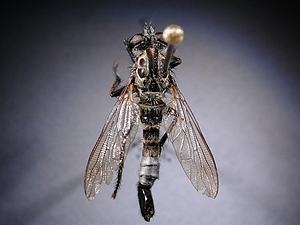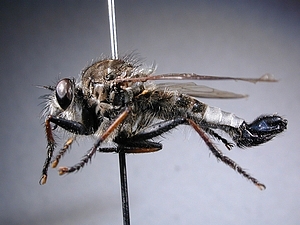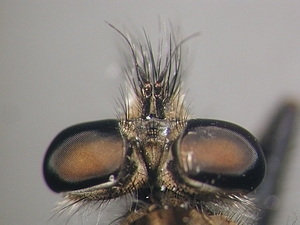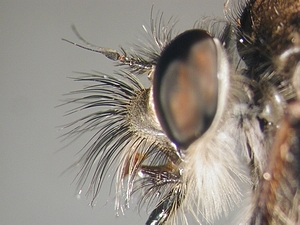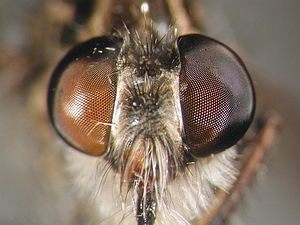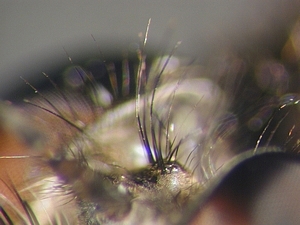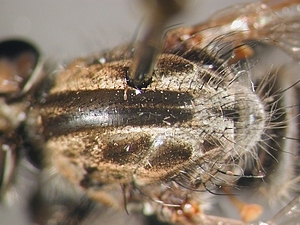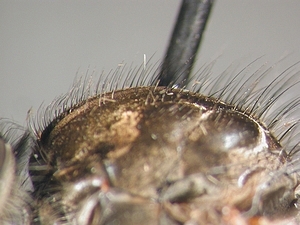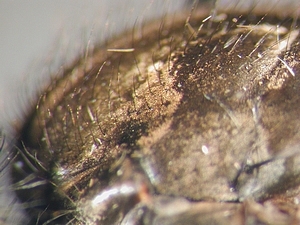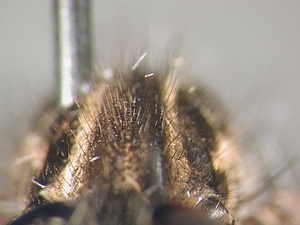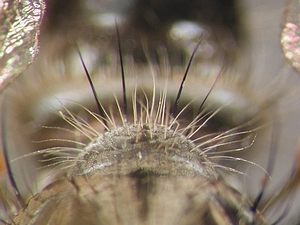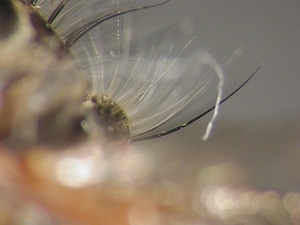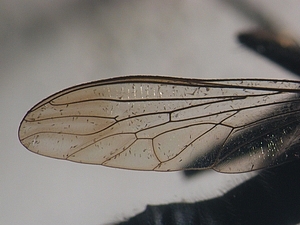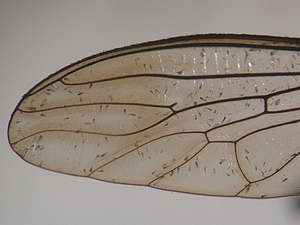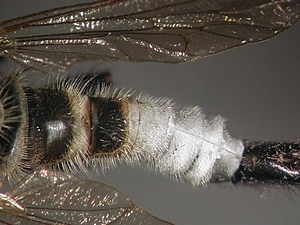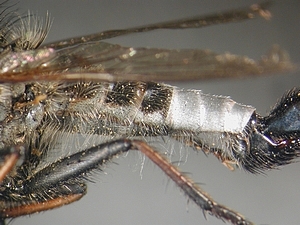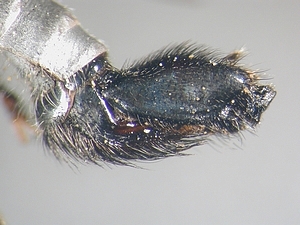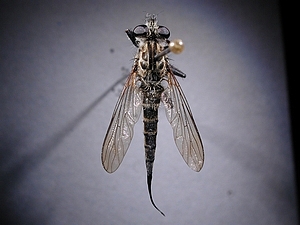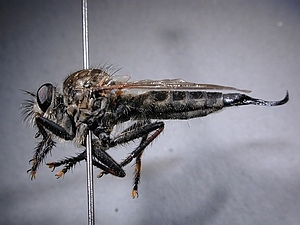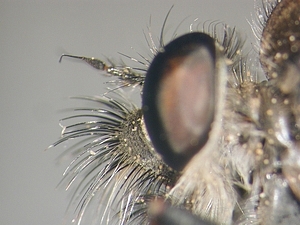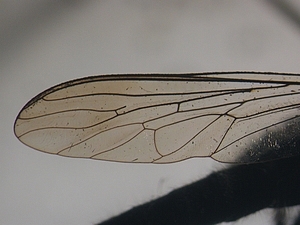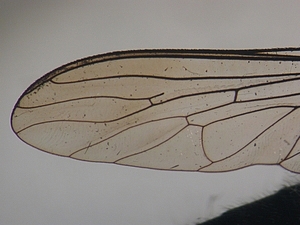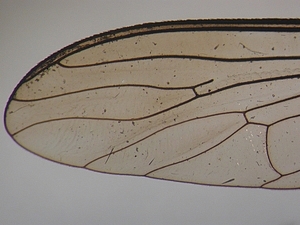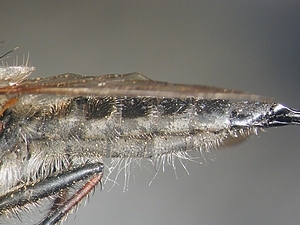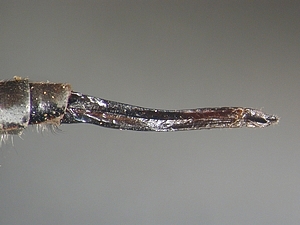Apocleinae
Amblyonychus
Eccritosia
Furcilla
Mallophora
Megaphorus
Nevadasilus
Proctacanthella
Proctacanthus
Promachella
Promachus
Efferia-group
Albibarbefferia
Aridefferia
Carinefferia
Efferia
Nerax *
Pogonioefferia
Triorla
Tuberculefferia
[Apocleinae: Efferia-group]
| Neotropical | Nearctic | Palaearctic | Afrotropical | Oriental | Australian & Oceania |
| typ.loc. |
| Description: | Hull, F.M. (1962): Robber flies of the world. - Bulletin of the United States National Museum 224 (1, 2): 1-907 [476]; Washington. |
| Type species: | Asilus aestuans Linnaeus, 1763: 413 |
| Literature: | Coquillett, D.W. (1893): A new asilid genus related to Erax. - The Canadian Entomologist 25: 175-177; Ottawa [key]. Hine, J.S. (1919): Robber flies of the genus Erax. - Annals of the Entomological Society of America 12(2): 103-157, pls. 7-9; Columbus [key]. Wilcox, J. (1966): Efferia Coquillett in America North of Mexico (Diptera, Asilidae). - Proceedings of the California Academy of Sciences 34: 85-234; San Francisco [key]. Parks, L. (1968): Synopsis of robberfly genera allied to Efferia and Eicherax, including a new genus. - Pan-Pacific Entomologist 44: 171-179; San Francisco [key]. Bullington, S.W. & Lavigne, R.J. (1984): Description and habitat of Efferia kondratieffi sp. nov. with notes on Efferia aestuans (L.) (Diptera: Asilidae). - Annals of the Entomological Society of America 77: 404-413; Columbus [key]. |
Nearctic species:
- male -
Unrecognized species: Nerax antiphon (Walker, 1849) from Georgia; Nerax macrolabis (Wiedemann, 1828) from Kentucky; Nerax stylatus (Fabricius, 1775) (= Erax haitensis Macquart, 1848) from Florida, and females of Nerax slossonae (Hine, 1919).
| Males. |
| |
| Females. |
|
| Six or more marginal scutellar bristles. Tergites 5-7 silvery pollinose. |
| |
| Usually two scutellar marginal bristles. At most tergites 6-7 silvery pollinose. |
|
| Scutum anteriorly with very short black hair. Length 26-30 mm . . . . . Nerax femoratus (Macquart, 1838) [SC, NC, LA, FL, GA] | ||
| Hairs of anterior scutum as long or longer than scape. |
|
| Epandria 2.7-3.7 mm long, apices either as in Fig. 11 and 12 or in Fig. 13 and 14 (Bullington & Lavigne, 1984: 407). Length 10-18 mm (Wilcox, 1966: 14-28 mm) . . . . . Nerax aestuans (Linnaeus, 1763) [PA, ND, WY, CO, NM, SD, NE, KS, OK, TX, MN, IA, MO, AR, LA, WI, IL, MS, MI, IN, KY, TN, AL, GA, FL, OH, WV, VA, NC, SC, NY, NH, MI, MD, UT, ONT] | ||
| Epandria 2.1-2.7 mm long from ventrobasal knob to dorsoapical tooth, apices either as in Fig. 6 and 7 (Bullington & Lavigne, 1984: 405). Length 9-14 mm . . . . . Efferia kondratieffi Bullington & Lavigne, 1984 [KS, OK, TX] |
| Mystax yellowish. Gonocoxite with a dense fringe of brownish hairs, longer than scape, pedicel, and postpedicel combined. Length 13-15 mm . . . . . Nerax aurimystaceus (Hine, 1919) [KS, OK, TX] | ||
| Mystax black with a few white hairs intermixed. Gonocoxite with a sparse fringe of brown and black hairs subequal in length to scape and pedicel combined. Length 10-14 mm . . . . . Nerax belfragei (Hine, 1919) [TX, OK?] |
| Ovipositor 6 mm long or longer. |
| |
| Ovipositor at most 5.5 mm long, usually shorter. |
|
| Hairs anteriorly on the scutum shorter than pedicel. Tibiae and tarsomeres dark reddish. Ovipositor 7.3 mm long . . . . . Nerax femoratus (Macquart, 1838) [SC, NC, LA, FL, GA] | ||
| Hairs anteriorly on the scutum as long as antennal scape. Tips of the tibiae and tarsomeres black. Ovipositor 6.0 mm long . . . . . Nerax aestuans (Linnaeus, 1763) [PA, ND, WY, CO, NM, SD, NE, KS, OK, TX, MN, IA, MO, AR, LA, WI, IL, MS, MI, IN, KY, TN, AL, GA, FL, OH, WV, VA, NC, SC, NY, NH, MI, MD, UT, ONT] |
| Tergites 2-5 gray pollinose and mostly short white haired. Ovipositor 4.0 mm long . . . . . Nerax kansensis (Hine, 1919) [VA, PA, MD, NJ, NY] | ||
| Tergites 2-5 black dorsally. |
|
| 4 marginal scutellar bristles. Ovipositor 3.7 mm long . . . . . Nerax beameri (Wilcox, 1966) [TX] | ||
| 6 marginal scutellar bristles. Ovipositor 3.2-4.4 mm long . . . . . Efferia kondratieffi Bullington & Lavigne, 1984 [KS, OK, TX] |
| Ovipositor gradually narrowing apically, 4.1-5.5 mm long. Narrow dorsum and posterior margin of tergite 7 brownish pollinose . . . . . Nerax tabescens (Banks in Hine, 1919) [FL, GA] | ||
| Ovipositor narrowed byond basal one-third, 4.1-4.5 mm long. Tergite 7 shining black . . . . . Nerax apicalis (Wiedemann, 1821) [GA, TX, LA, MS, AL, FL, SC, NC] |
Contents: © Fritz Geller-Grimm, Jorge N. Artigas, 2007
Layout & images: © Fritz Geller-Grimm, 2007
